
Dilophosaurus is a genus of theropod dinosaurs that lived in what is now North America during the Early Jurassic, about 186 million years ago. Three skeletons were discovered in northern Arizona in 1940, and the two best preserved were collected in 1942. The most complete specimen became the holotype of a new species in the genus Megalosaurus, named M. wetherilli by Samuel P. Welles in 1954. Welles found a larger skeleton belonging to the same species in 1964. Realizing it bore crests on its skull, he assigned the species to the new genus Dilophosaurus in 1970, as Dilophosaurus wetherilli. The genus name means "two-crested lizard", and the species name honors John Wetherill, a Navajo councilor. Further specimens have since been found, including an infant. Fossil footprints have also been attributed to the animal, including resting traces. Another species, Dilophosaurus sinensis from China, was named in 1993, but was later found to belong to the genus Sinosaurus.
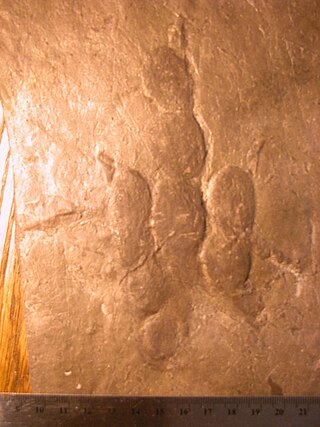
Grallator ["GRA-luh-tor"] is an ichnogenus which covers a common type of small, three-toed print made by a variety of bipedal theropod dinosaurs. Grallator-type footprints have been found in formations dating from the Early Triassic through to the early Cretaceous periods. They are found in the United States, Canada, Europe, Australia, Brazil and China, but are most abundant on the east coast of North America, especially the Triassic and Early Jurassic formations of the northern part of the Newark Supergroup. The name Grallator translates into "stilt walker", although the actual length and form of the trackmaking legs varied by species, usually unidentified. The related term "Grallae" is an ancient name for the presumed group of long-legged wading birds, such as storks and herons. These footprints were given this name by their discoverer, Edward Hitchcock, in 1858.

Dinosaur Stampede National Monument at Lark Quarry Conservation Park in Queensland, Australia is considered to be the site of the world's only known record of a dinosaur stampede, with fossilised footprints are interpreted as a predator stalking and causing a stampede of around 150 two-legged dinosaurs. This interpretation has been challenged in recent years, with evidence suggesting it may have been a natural river crossing.

Eubrontes is the name of fossilised dinosaur footprints dating from the Late Triassic and Early Jurassic. They have been identified from France, Poland, Slovakia, Czech Republic, Italy, Spain, Sweden, Australia (Queensland), US, India, China and Brazil (South).

Otozoum is an extinct ichnogenus of sauropodomorph dinosaur from the Late Triassic-Middle Jurassic sandstones. Footprints were made by heavy, bipedal or, sometimes, quadrupedal animals with a short stride that walked on four toes directed forward. These footprints are relatively large, over 20 cm in pes length. Otozoum differs from Plateosaurus by having a notable homopody.

Komlosaurus is an ichnogenus of theropod dinosaur from the Early Jurassic of Baranya, Hungary. The type species, Komlosaurus carbonis, was described by Kordos in 1983. The type remains come from the Mecsek Coal Formation, from the Middle Hettangian to the Early Sinemurian, and comprise several footprints.

Jialingpus is an ichnogenus of dinosaur, likely a theropod. Its footprints have been found in the Feitianshan Formation, a low-energy lake formation. Holotype is SCFP-24, which was found in Late Jurassic (Oxfordian)-aged Yuechi tracksite at Huanglong, China. These footprints were found within the vicinity of those of the smaller theropod Minisauripus, meaning that Jialingpus likely hunted Minisauripus.
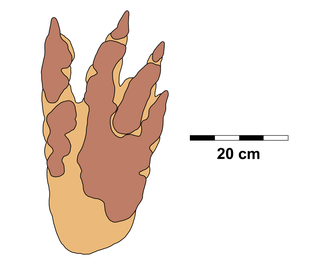
Macropodosaurus is an ichnogenus of therizinosaurid footprints from the Late Cretaceous of Asia, North America and Poland. The ichnogenus is currently monotypic only including the type ichnospecies M. gravis, described and named in 1964.
Navahopus is an ichnogenus of dinosaur footprint that was made by an indeterminate navahopodid sauropodomorph once thought to have been a prosauropod that was alive during the Early Jurassic in southwestern United States. Two ichnospecies are known: the type ichnospecies, N. falcipollex and a second species, N. coyoteensis. It is known from the Early Jurassic of Arizona, California and Utah.

Parabrontopodus is an ichnogenus of dinosaur footprint, that was initially described by Lockley et al. in 1994, and was assigned to Sauropoda by Lockley in 2002 and in 2004 by Niedzwiedzki and Pienkowski. Various species through their footprints that are characterized by the association of two impressions left by hand and foot. The acquisition of a specific family is complex, but now in most cases, they have been considered diplodocoids and similar animals. The reason is that their traces left are large, but in proportion to the size, from animals, seem very light because the depth of imprint is low.
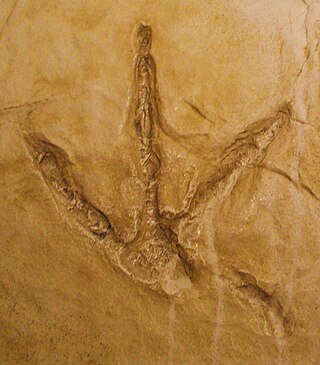
Saurexallopus is an ichnogenus of four-toed theropod footprints from the Late Cretaceous period. The type ichnospecies is S. lovei, named and described in 1996 from the Harebell Formation. The taxon was originally named Exallopus, but later renamed as Saurexallopus as the former was preoccupied by a polychaete. A second species, S.zerbsti, was named and described in 2004 from the Lance Formation. In 2012 a four-toed track from the Cantwell Formation was referred to Saurexallopus indet. It was also suggested that Saurexallopus was produced by a therizinosaur taxon. In 2013 based on skeletal proportions it was suggested that the ichnotaxon was instead produced by an oviraptorosaur taxon. In 2014 a third species was named, S.cordata, from the Wapiti Formation. In 2018 several tracks from the Blackhawk Formation were referred to Saurexallopus indet.
Abelichnus is an extinct ichnogenus of dinosaur footprint from the Candeleros Formation and the Rio Limay Formation. The type ichnospecies, Abelichnus astigerrae, was first discovered in Argentina in 1987 and was recorded as the biggest known dinosaur footprint ever discovered. Abelichnus probably grew to a size of 12.5-13 meters long.
Satapliasaurus is an extinct genus of theropod dinosaur known from multiple well-preserved trackways. Satapliasarus is known from three ichnospecies: S. dsocenidzei, Satapliasaurus kandelakii (ichnospecies) and Satapliasaurus tschabukianii. The fossils and trackways have been found in Cretaceous sediments of Georgia and the Middle Jurassic of England. The genus is named after the Sataplia Managed Reserve in Georgia.
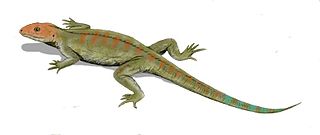
Steganoposaurus is an ichnogenus of fossil reptile footprints. The ichnospecies Steganoposaurus belli, was erected for footprints discovered in Wyoming's Tensleep Sandstone. The find was first reported to the scientific literature by Edward Branson and Maurice Mehl in 1932. This creature was originally presumed to be an amphibian, but the toe prints it left behind were pointed like a reptile's rather than round like an amphibians. The actual trackmaker may have been similar to the genus Hylonomus. The ichnogenus Tridentichnus are similar footprints preserved in the Supai Formation of Arizona.
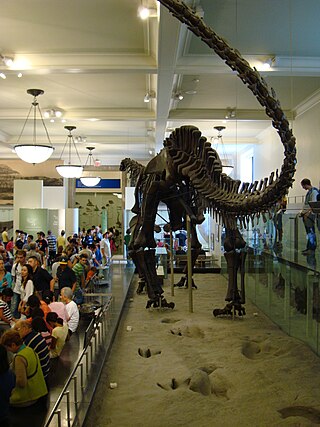
The 20th century in ichnology refers to advances made between the years 1900 and 1999 in the scientific study of trace fossils, the preserved record of the behavior and physiological processes of ancient life forms, especially fossil footprints. Significant fossil trackway discoveries began almost immediately after the start of the 20th century with the 1900 discovery at Ipolytarnoc, Hungary of a wide variety of bird and mammal footprints left behind during the early Miocene. Not long after, fossil Iguanodon footprints were discovered in Sussex, England, a discovery that probably served as the inspiration for Sir Arthur Conan Doyle's The Lost World.

The 19th century in ichnology refers to advances made between the years 1800 and 1899 in the scientific study of trace fossils, the preserved record of the behavior and physiological processes of ancient life forms, especially fossil footprints. The 19th century was notably the first century in which fossil footprints received scholarly attention. British paleontologist William Buckland performed the first true scientific research on the subject during the early 1830s.

The Scalby Formation is a geological formation in England. Part of the Ravenscar Group, it was deposited in the Bathonian stage of the Middle Jurassic. The lower Moor Grit Member has a lithology consisting of medium to coarse grained cross bedded sandstone, with thin beds of mudstone and siltstone, while the upper Long Nab Member has a lithology consisting of predominantly laminated mudstone and siltstone, with fine to medium grained planar and cross stratified sandstones.
This article records new taxa of trace fossils of every kind that are scheduled to be described during the year 2019, as well as other significant discoveries and events related to trace fossil paleontology that are scheduled to occur in the year 2019.

Bellatoripes is an ichnogenus of footprint produced by a large theropod dinosaur so far known only from the Late Cretaceous of Alberta and British Columbia in Canada. The tracks are large and three-toed, and based on their size are believed to have been made by tyrannosaurids, such as Albertosaurus and Daspletosaurus. Fossils of Bellatoripes are notable for preserving trackways of multiple individual tyrannosaurids all travelling in the same direction at similar speeds, suggesting the prints may have been made by a group, or pack, of tyrannosaurids moving together. Such inferences of behaviour cannot be made with fossil bones alone, so the record of Bellatoripes tracks together is important for understanding how large predatory theropods such as tyrannosaurids may have lived.
Wakinyantanka is an ichnogenus of footprint produced by a large theropod dinosaur from the Late Cretaceous Hell Creek Formation of South Dakota. Wakinyantanka tracks are large with three long, slender toes with occasional impressions of a short hallux and narrow metatarsals. Wakinyantanka was the first dinosaur track to be discovered in the Hell Creek Formation, which remain rare in the preservational conditions of the rocks. The potential trackmakers may be a large oviraptorosaur or a small tyrannosaurid.














